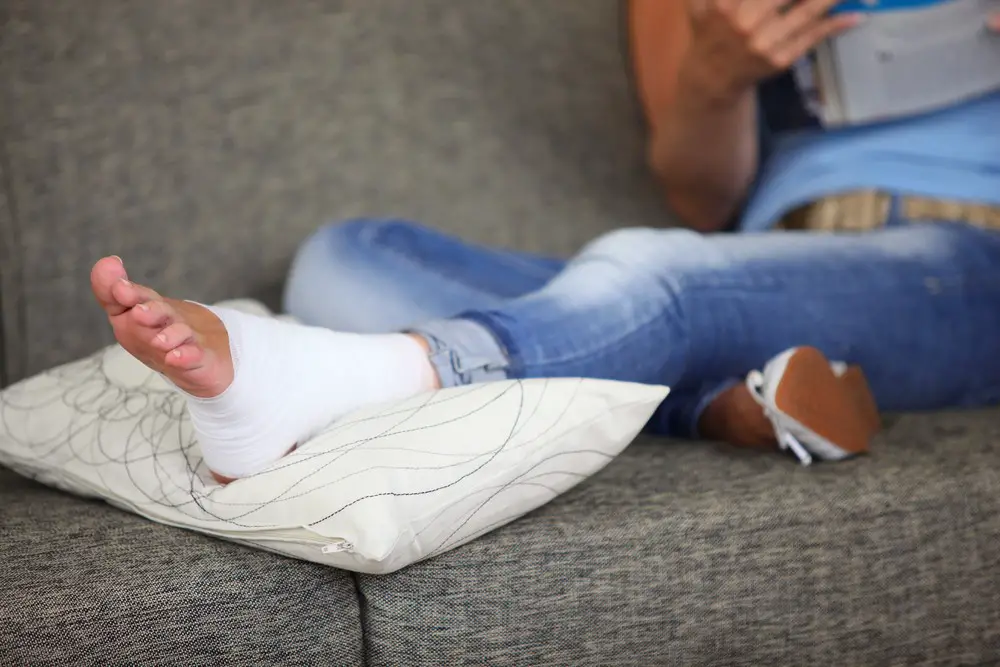As a BetterHelp affiliate, we receive compensation from BetterHelp if you purchase products or services through the links provided
Sprained ankles are a common injury that can cause discomfort and difficulty carrying out daily activities. A sprained ankle can be particularly challenging when getting a good night’s sleep. This article will explain how to safely and comfortably sleep with a sprained ankle, offering a combination of expert advice and practical tips that can help speed up the healing process.
Understanding the nature of a sprained ankle and the importance of adequate rest for optimal recovery is crucial. Alongside professional medical recommendations, applying specific techniques and adjusting to sleeping positions can greatly improve comfort levels and lead to a more restful night’s sleep.
Key Takeaways
- Prioritize rest and sleep for a faster recovery
- Utilize special techniques to minimize discomfort in bed
- Follow professional advice and appropriate treatments to shorten the healing process
 Understanding Sprained Ankle
Understanding Sprained Ankle
A sprained ankle occurs when the ligaments that support the ankle joint are stretched or torn. Ligaments are strong, fibrous tissues that connect bones to each other and stabilize the joint.
Causes of Ankle Sprains
Ankle sprains can happen to anyone and are often caused by:
- Twisting or rolling the ankle while walking or running
- Stepping on an uneven surface or object
- Participating in sports that involve jumping and landing
- Wearing inappropriate footwear
- Having weak muscles or poor balance
Symptoms and Grades of Sprained Ankle
The severity of an ankle sprain is usually classified into three grades, depending on the symptoms and extent of ligament damage:
- Grade 1: Mild symptoms, such as slight pain and swelling. Ligaments are stretched but not torn.
- Grade 2: Moderate symptoms, including ankle pain and swelling, tenderness, and mild instability. Partial tearing of the ligament occurs.
- Grade 3: Severe symptoms, such as significant swelling and bruising, intense pain, and ankle instability. This indicates a complete tear of the ligament.
It’s essential to understand the severity of the sprain and follow the appropriate treatment plan to ensure proper recovery and prevent further injury.
 First Aid and Initial Treatment
First Aid and Initial Treatment
Rest
When dealing with a sprained ankle, it’s essential for the injured person to rest and avoid putting weight on the affected ankle. This allows the injury to heal without further stress to the area. Crutches or a walking boot can provide support, while minimizing weight-bearing.
Ice
Applying ice to the sprained ankle helps reduce pain and inflammation. It’s crucial to do this as soon as possible after the injury. Use a cold pack or a bag of ice wrapped in a towel, and place it on the ankle for 20 minutes at a time, every 1-2 hours for the first 48-72 hours.
Compression
Wrapping the injured ankle with an elastic compression bandage provides support and helps minimize swelling. Begin wrapping at the toes and progress up the leg, overlapping each layer by half the width of the bandage. However, be cautious not to wrap it too tightly, as this can restrict blood flow.
Elevation (RICE) Method
Elevating the injured ankle above heart level helps reduce swelling and promotes healing. This position should be maintained as much as possible for the first 48 hours. Use pillows or cushions to prop the leg up in a comfortable position.
Medication for Pain and Inflammation
Over-the-counter pain relievers and anti-inflammatory drugs, such as ibuprofen, can help manage pain and reduce inflammation in a sprained ankle. It’s essential to follow the recommended dosage instructions and consult a healthcare professional before taking any medication, especially if there are any pre-existing conditions or allergies.
By following the aforementioned RICE (Rest, Ice, Compression, Elevation) method and using appropriate medication, the person with a sprained ankle can alleviate pain and promote faster healing.
 Sleeping with a Sprained Ankle
Sleeping with a Sprained Ankle
Best Sleeping Positions
When sleeping with a sprained ankle, it is crucial to find a comfortable and supportive position to promote healing and prevent further injury. The following sleeping positions can help alleviate discomfort and ensure a restful and pain-free sleep:
- On the back: Sleeping on the back with the injured ankle elevated allows for proper blood circulation and reduces swelling. Make sure the foot is elevated above the heart level to achieve optimal results.
- On the side: If sleeping on the back is uncomfortable, an alternative is lying on the unaffected side with a pillow between the legs to cushion the injured ankle and maintain proper body alignment.
Use of Pillows for Support
Pillows play a key role in providing support and comfort when sleeping with a sprained ankle. Here are a few ways to effectively use pillows to achieve the best results:
- Elevate the ankle: Place a few pillows or a specialized foam cushion beneath the sprained ankle when sleeping on the back. This helps to elevate the foot above the heart, reducing swelling and pain.
- Cushion between legs: When sleeping on the side, use a pillow between the legs to prevent the injured ankle from rubbing against the other leg or becoming twisted in the sheets.
- Support for body alignment: When lying on the unaffected side, it can be helpful to use a body pillow or additional pillows for support, ensuring proper spinal alignment and helping to avoid shifting onto the injured ankle during the night.
Special Techniques for Comfort and Healing
Methods to Reduce Swelling
Swelling is a natural occurrence when dealing with a sprained ankle, but reducing it can significantly impact the healing process. Several methods can be used to minimize swelling:
- Cold compress: Apply a cold pack or ice wrapped in a towel to the affected area for 20 minutes every 2-3 hours during the first 48 hours. This helps constrict blood vessels, reducing inflammation and pain.
- Elevation: Elevate the injured ankle above the level of the heart, ideally keeping it propped up on a pillow, for the first 48 hours. This helps control swelling by encouraging fluids to drain away from the injury area.
- Arnica cream: A natural remedy, arnica cream can be applied topically to the ankle to reduce inflammation and promote healing.
Ankle Exercises for Range of Motion
Once the initial swelling has decreased, incorporating gentle ankle exercises can help improve range of motion and promote healing. It is important to consult with a physical therapist before starting any exercises to ensure appropriate techniques are used. Some exercises to consider include:
- Ankle circles: While seated, slowly rotate the injured ankle in a circle, then in the opposite direction. Repeat 10 times in each direction.
- Alphabet writing: Use the injured ankle to “write” the alphabet in the air, moving through each letter’s shape. This encourages a full range of motion in the ankle.
- Towel stretch: Sit on the floor with legs extended, and wrap a towel around the ball of the injured foot. Gently pull the towel toward you, feeling the stretch in the ankle. Hold for 15-30 seconds, then repeat 3 times.
Use of Compression and Elastic Bandages
Utilizing compression and elastic bandages can support the sprained ankle and help reduce swelling. Two key components to consider are:
- Compression bandage: A compression bandage should be applied within the first 48 hours of injury, and while the ankle is elevated. Start wrapping from just below the toes, ensuring the bandage is snug but not too tight. Each wrap should overlap the previous one, ending just above the ankle.
- Elastic bandage: After the initial 48 hours, an elastic bandage can be used to provide support and compression while still allowing for movement in the ankle. Similar to the compression bandage, start wrapping from below the toes and end just above the ankle. The elastic bandage should be adjusted as swelling decreases to ensure proper support.
By following these special techniques, one can promote comfort and healing while dealing with a sprained ankle. Always consult with a healthcare professional or physical therapist to ensure the appropriate steps are taken for a swift recovery.
Managing Daily Activities With a Sprained Ankle
Walking and Weight Bearing
When dealing with a sprained ankle, it is important to gradually return to walking and weight-bearing activities. Start with partial weight-bearing, using your uninjured leg for support. As you gain confidence and your ankle feels stronger, gradually increase the amount of weight you put on the injured ankle. Remember to listen to your body and not push yourself too hard, as this can cause further injury.
Use Of A Brace or Splint
An ankle support brace or walking boot can be beneficial in providing stability and support for a sprained ankle. These devices help to immobilize the joint, preventing further injury and allowing the healing process to begin. When selecting a brace, consider the following factors:
- Comfort: Choose a comfortable and well-fitted brace that provides ample support without causing pain or discomfort.
- Adjustability: Look for a brace that can be easily adjusted to fit your ankle comfortably.
- Durability: Select a high-quality brace that will last throughout your recovery period.
When to Use Crutches
Crutches can be an essential aid for those dealing with a severely sprained ankle. They help to reduce the amount of weight placed on the injured ankle, promoting healing while allowing you to maintain mobility. Consider using crutches in these scenarios:
- Severe pain: If walking or weight-bearing activities cause extreme pain even with a brace or splint, crutches may be necessary.
- Swelling: Prolonged swelling of the ankle may indicate a severe sprain requiring the use of crutches to minimize weight-bearing.
- Doctor’s recommendation: Always follow the advice of your healthcare provider when it comes to using crutches during your recovery period.
While managing daily activities with a sprained ankle may be challenging, using the appropriate support devices, such as an ankle brace, walking boot, or crutches, can make the process more manageable. By following these guidelines and consulting with your healthcare provider, you can ensure the best possible outcome for your ankle injury.
Follow up Treatment and Recovery
Recovery Expectations
After a sprained ankle, it is important to manage inflammation to promote healing. Rest, ice, compression, and elevation (RICE) are essential during the initial stages of recovery. A gradual return to daily activities and exercise should be expected, with healing time usually between two to six weeks depending on the severity of the sprain.
During this period, it is crucial to be gentle with the affected ankle to prevent re-injury. Utilize mobility aids such as crutches or a brace, if necessary, to assist with stabilization and support. Pain and swelling should gradually decrease over time. If improvement is not observed, consult a healthcare professional for a physical examination.
Long Term Prevention and Strengthening
To prevent future ankle sprains and improve overall ankle stability, incorporate strengthening exercises into your routine. Some effective exercises for building muscle strength in the ankle include:
- Ankle circles: Rotate the ankle in a circular motion for several repetitions.
- Calf raises: Stand on your toes, then lower back down. Repeat for multiple sets.
- Resistance band exercises: Perform inversion and eversion movements with a resistance band around the affected ankle.
In addition to these exercises, maintaining a healthy lifestyle and participating in regular physical activity can contribute to regeneration and growth hormone production, which aid in the long-term prevention of ankle sprains.
Potential Complications
If not properly cared for, complications may arise from a sprained ankle. These include:
- Chronic ankle instability
- Persistent pain and swelling
- Development of arthritis in the affected joint
- Formation of scar tissue, leading to restricted ankle mobility
Seek medical attention if any complications are suspected, as early intervention may reduce the risk of long-term issues.
Next Steps
During the recovery process, continue to monitor the healing progress of the sprained ankle. Regularly assess pain levels, inflammation, and range of motion to determine if improvement is occurring. If complications or stagnation in healing are observed, it may be necessary to consult a healthcare professional for further evaluation and potential treatments.
Severe Cases and Surgical Intervention
Determining the Need for Surgery
In some severe cases, a sprained ankle may require surgery. If an athlete or an individual with a history of recurrent ankle sprains suffers from a severe sprain, medical assessment is crucial. A detailed examination and an X-ray will be conducted by a sports medicine specialist or a doctor to determine the severity of the injury. Fractures or significant ligament damage can be identified through this process.
Surgery may be recommended if there are complete tears of the ligaments, instability after the initial healing phase, or if the individual has a history of ankle injuries that result in chronic pain and instability. In cases where the ligament is stretched or torn, surgical intervention can help to restore stability and prevent further injury.
Post-Surgical Care
Post-surgical care is an important aspect of recovery. Following surgery, the affected ankle will be immobilized in a cast or a brace to protect and support the repaired ligaments. The doctor will usually recommend:
- Rest: Keeping the ankle elevated can help reduce swelling and promote healing.
- Ice: Applying cold packs periodically throughout the day can minimize swelling and pain.
- Compression: Wearing an elastic bandage or compression stocking can provide additional support and prevent swelling.
- Pain Management: Doctors might prescribe pain-relief medications and anti-inflammatories to ensure a comfortable recovery.
It is essential to follow the doctor’s guidelines and attend regular follow-up appointments to monitor progress.
Recovery
Recovery from a severe ankle sprain surgery typically takes a few months. Rehabilitation is an integral part of the recovery process and often involves a combination of physical therapy and at-home exercises. During rehab, the focus will be on regaining strength, range of motion, and stability in the ankle. Gradual return to physical activities is to be expected, and medical professionals will closely monitor the healing process to ensure a safe and successful recovery.
In conclusion, severe ankle sprains that require surgical intervention demand proper medical attention, post-surgical care, and rehabilitation for a successful healing process. The combination of these elements minimizes the risk of future injury and helps individuals regain their strength and mobility.
Frequently Asked Questions
How can I reduce throbbing pain at night?
To reduce throbbing pain at night, elevating the injured ankle above heart level can help. Use pillows to prop up the foot and minimize swelling. Applying ice packs for 15-20 minutes every hour before bed can also alleviate pain. Taking over-the-counter pain relievers as advised by your doctor can make the night more comfortable.
Is it okay to sleep on my stomach?
Sleeping on the stomach may not be the best position for a sprained ankle. It’s better to sleep on the back or side, with the injured ankle elevated and supported by pillows. This will help reduce pain and swelling during the night.
Should I wear compression while sleeping?
Wearing a compression bandage or sock while sleeping can provide support and help control swelling. However, make sure it isn’t too tight, as this can restrict blood circulation. Remove the compression if it becomes uncomfortable or causes numbness, tingling, or more pain.
What precautions should be taken overnight?
Taking precautions while sleeping with a sprained ankle can minimize the chances of worsening the injury. Use a nightlight to avoid stumbling in the dark, and clear any clutter from the path between your bed and the bathroom. Make sure the injured ankle is well-supported and elevated throughout the night.
Do I need to wrap my ankle before bed?
Wrapping the ankle with an elastic bandage before bed can provide support and compression, reducing swelling overnight. Ensure that it is snug but not too tight. If it causes discomfort or affects circulation, remove or loosen the wrap.
What can I do to minimize pain during sleep?
Minimizing pain during sleep involves several simple strategies: elevate the injured ankle using pillows, apply ice packs before bed, take over-the-counter pain relief, and maintain a comfortable and supportive sleeping position. Practicing relaxation techniques or using a white noise machine can help create a more conducive environment for sleep.
- Breaking the Silence: Why Men’s Mental Health Matters More Than Ever - April 15, 2025
- How to Transform a Home’s Patio Space into a Relaxing Space - March 23, 2025
- 5 Strategies to Use a Cell Phone to Help Manage Your Stress - March 23, 2025
This site contains affiliate links to products. We will receive a commission for purchases made through these links.


 Understanding Sprained Ankle
Understanding Sprained Ankle First Aid and Initial Treatment
First Aid and Initial Treatment Sleeping with a Sprained Ankle
Sleeping with a Sprained Ankle
